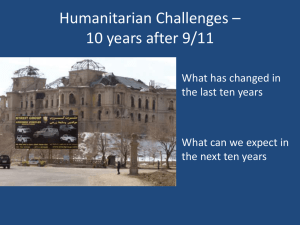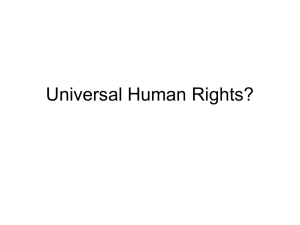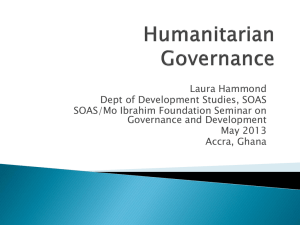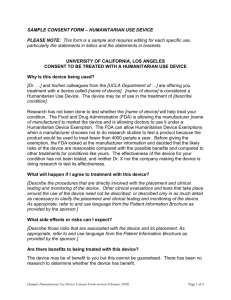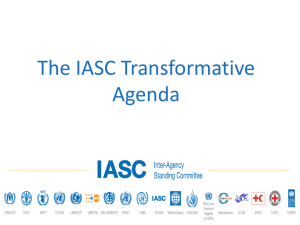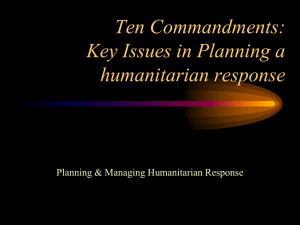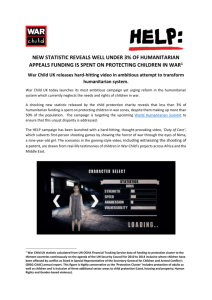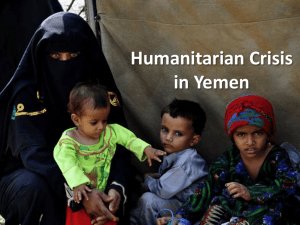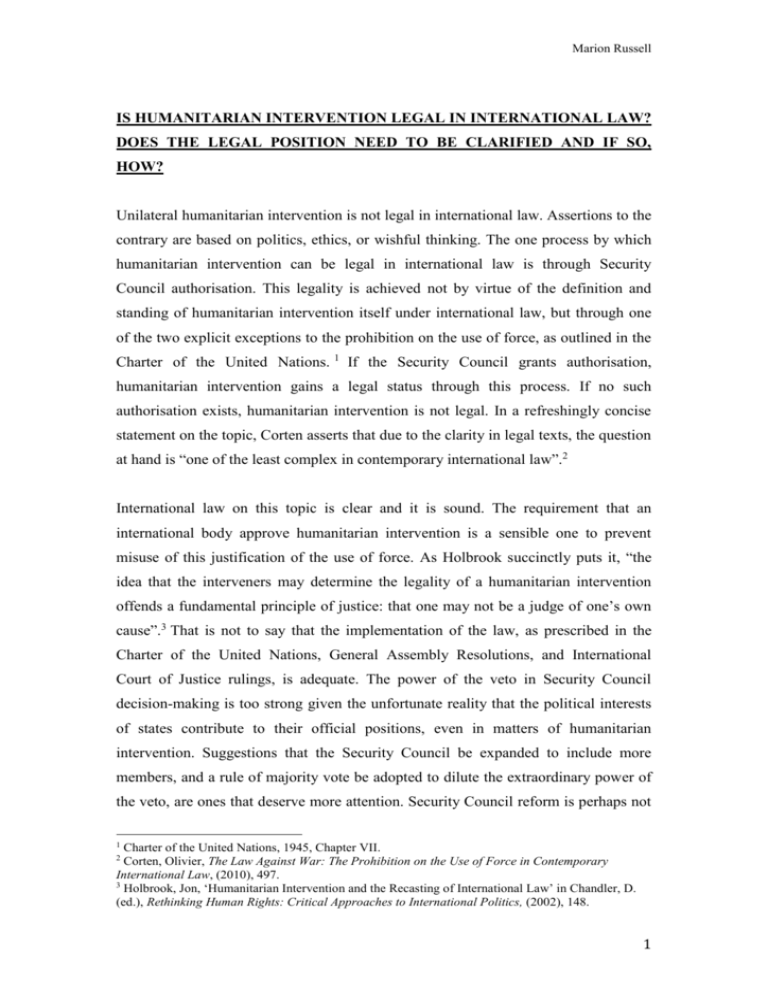
Marion Russell
IS HUMANITARIAN INTERVENTION LEGAL IN INTERNATIONAL LAW?
DOES THE LEGAL POSITION NEED TO BE CLARIFIED AND IF SO,
HOW?
Unilateral humanitarian intervention is not legal in international law. Assertions to the
contrary are based on politics, ethics, or wishful thinking. The one process by which
humanitarian intervention can be legal in international law is through Security
Council authorisation. This legality is achieved not by virtue of the definition and
standing of humanitarian intervention itself under international law, but through one
of the two explicit exceptions to the prohibition on the use of force, as outlined in the
Charter of the United Nations. 1 If the Security Council grants authorisation,
humanitarian intervention gains a legal status through this process. If no such
authorisation exists, humanitarian intervention is not legal. In a refreshingly concise
statement on the topic, Corten asserts that due to the clarity in legal texts, the question
at hand is “one of the least complex in contemporary international law”.2
International law on this topic is clear and it is sound. The requirement that an
international body approve humanitarian intervention is a sensible one to prevent
misuse of this justification of the use of force. As Holbrook succinctly puts it, “the
idea that the interveners may determine the legality of a humanitarian intervention
offends a fundamental principle of justice: that one may not be a judge of one’s own
cause”.3 That is not to say that the implementation of the law, as prescribed in the
Charter of the United Nations, General Assembly Resolutions, and International
Court of Justice rulings, is adequate. The power of the veto in Security Council
decision-making is too strong given the unfortunate reality that the political interests
of states contribute to their official positions, even in matters of humanitarian
intervention. Suggestions that the Security Council be expanded to include more
members, and a rule of majority vote be adopted to dilute the extraordinary power of
the veto, are ones that deserve more attention. Security Council reform is perhaps not
1
Charter of the United Nations, 1945, Chapter VII.
Corten, Olivier, The Law Against War: The Prohibition on the Use of Force in Contemporary
International Law, (2010), 497.
3
Holbrook, Jon, ‘Humanitarian Intervention and the Recasting of International Law’ in Chandler, D.
(ed.), Rethinking Human Rights: Critical Approaches to International Politics, (2002), 148.
2
1
Marion Russell
entirely relevant to the matter at hand. The point here is that the focus of debate
should reflect the fact that it is the process, not the law, which requires clarification
and possible amendment.
Aside from the defects of the Security Council approval process, state practice exists
of unilateral intervention where authorisation was either never sought, or was sought
but not granted. Some argue that unauthorised unilateral humanitarian intervention is,
in fact, legal in international law. Others assert that such intervention may not be
legal, but can be mitigated by being referred to as legitimate or justifiable. Both
positions undermine the rule of international law. It must be emphasised that
international law regarding humanitarian intervention is not violated because it is
unclear – it is violated because it can be inconvenient.
Arguments that assert a right of unilateral humanitarian intervention are entirely
unconvincing. Convenient but deeply flawed interpretations of the Charter of the
United Nations are adopted and the plain meaning of the words of the Charter is
ignored. A right of unilateral humanitarian intervention under customary international
law has also been claimed. Adequate state practice and opinio juris simply do not
exist to justify the formation of such a right.
At the other end of the spectrum, assertions that humanitarian intervention violates
state sovereignty and should be outlawed completely overlook the fact that state
sovereignty and human rights coexist in international law texts. Both concepts are
provided for, and regarded as fundamental principles, in the Charter of the United
Nations. State sovereignty and human rights should not be regarded as mutually
exclusive in any way. It must be acknowledged, however, that human rights can no
longer be regarded as an entirely domestic concern. The Security Council has the
power to approve intervention, when human rights violations are occurring, by
adopting a wide but not at all unrealistic reading of the term “international peace and
security”4 which the Security Council is charged to “maintain or restore”.5
4
5
Charter of the United Nations, 1945, Article 39.
Charter of the United Nations, 1945, Article 39.
2
Marion Russell
Discussions that assert that humanitarian intervention can be legitimate but not legal
are unhelpful at best. To add this grey, moral judgement aspect to what should be a
legal debate, undermines the rule of law. It suggests that violation of international law
can be acceptable, that such violations can occupy a space somewhere between
legality and illegality. The clear and absolute position of international law, the power
of reciprocity and adherence to the law is from where international law gains its
power, if it is to have any at all.
For the purposes of the current paper, the term “humanitarian intervention” will refer
to authorised or unauthorised (unilateral) interference in a foreign state’s affairs that
has the following qualities. Firstly, the interference must involve force, and not just
refer to sanctions and other measures short of the use of force, that can be regarded as
types of interference.6 Humanitarian intervention does not depend on “the consent of
rulers”7 who may in fact be responsible for the humanitarian situation in their state.
Furthermore, if not defined as humanitarian intervention, the action taken would
otherwise be regarded as an aggressive act.8
Humanitarian concerns must be the primary motivation for the action taken.9 Lepard
suggests a more pessimistic but realistic definition regarding the purposes of the
intervention, describing them as “ostensibly humanitarian”. 10 Contrary to some
definitions,11 it is not relevant to which state the individuals to be assisted belong.
They may be nationals of the intervening state or states, or citizens of the ‘target’
state, or any other. Breau asserts that “threatened military actions” as well as actual
6
United Nations General Assembly Resolution 2131, Declaration on the Inadmissibility of
Intervention in the Domestic Affairs of States and the Protection of Their Independence and
Sovereignty, (21 December 1965),
7
Cushman, Thomas ‘The Human Rights Case for the War in Iraq: A Consequentialist View’ in
Wilson, Richard Ashby (ed.), Human Rights in the ‘War on Terror’, (2005), 86.
8
Cushman, Thomas ‘The Human Rights Case for the War in Iraq: A Consequentialist View’ in
Wilson, Richard Ashby (ed.), Human Rights in the ‘War on Terror’, (2005), 85.
9
Roth, Kenneth, ‘War in Iraq: Not a Humanitarian Intervention’ in Byers, Michael, War Law:
International Law and Armed Conflict, (2005), 155, Cushman, Thomas ‘The Human Rights Case for
the War in Iraq: A Consequentialist View’ in Wilson, Richard Ashby (ed.), Human Rights in the ‘War
on Terror’, (2005), 86.
10
Lepard, Brian D., Rethinking Humanitarian Intervention: A Fresh Legal Approach Based on
Fundamental Ethical Principles in International Law and World Religions, (2002), 3.
11
Breau, Susan, Humanitarian Intervention: The United Nations & Collective Responsibility, (2005),
29; “A major purpose of the intervention for the intervening state or states is for the protection of
individuals or groups of individuals from their own state”.
3
Marion Russell
military actions fall under the definition of humanitarian intervention. 12 The current
paper will not adopt that position.
Cushman adds the interesting requirement that the action “must be publicly
acknowledged as a humanitarian intervention, and the humanitarian goals must be
specified”.13 It is unclear whether this assertion is not commonly found in definitions
of humanitarian intervention because it is regarded as obvious and intuitive, or
because the explicit identification of humanitarian goals is not in fact a requirement of
such action. Such specification of goals is certainly desirable and may go some way to
clarify and present for scrutiny, the objectives of so-called humanitarian intervention.
Article 2(4)
Article 2(4) of the Charter reads as follows:
All Members shall refrain in their international relations from the threat or use of force
against the territorial integrity or political independence of any state, or in any other
manner inconsistent with the Purposes of the United Nations14
The correct interpretation of this article is the most obvious one; “the use of force
across borders is simply not permitted”.15 This position is supported not only by the
commonsensical reading of the article, but also by the Vienna Convention on the Law
of Treaties as well as the “context, object and purpose” of the Charter.16 Given the
fact that international law draws its strength from such strong and thorough principles,
it is unlikely that this language of the article should be construed in any other way.
Essentially, there exists an “intention to provide a strong and prima facie general
12
Breau, Susan, Humanitarian Intervention: The United Nations & Collective Responsibility, (2005),
29.
13
Cushman, Thomas ‘The Human Rights Case for the War in Iraq: A Consequentialist View’ in
Wilson, Richard Ashby (ed.), Human Rights in the ‘War on Terror’, (2005), 86.
14
Charter of the United Nations, 1945, Article 2(4).
15
Byers, Michael, Simon Chesterman, ‘Changing the rules about rules? Unilateral humanitarian
intervention and the future of international law’ in Holzgrefe, J. L., Robert O. Keohane (eds.),
Humanitarian Intervention: Ethical, Legal, and Political Dilemmas, (2003), 181.
16
Byers, Michael, War Law: International Law and Armed Conflict, (2005), 15.
4
Marion Russell
prohibition on the use of force by States acting otherwise than with the authorization
of the appropriate organ of the United Nations”.17
Despite this, there are those who contend that Article 2(4) does not represent a “flat
prohibition”18 on the use of force or humanitarian intervention.19 Proponents of this
view assert that Article 2(4) attempts to “establish three target prohibitions”,20 rather
than a general prohibition. What follows is the argument that if humanitarian
intervention or any act of force does not 1) breach the territorial integrity of the target
state, or 2) jeopardise the political independence of the target state, or 3) cause
inconsistencies to arise with the Purposes of the United Nations, then it is not an
illegal use of force.
Even if the argument that Article 2(4) establishes three specific prohibitions on the
use of force rather than one general prohibition is accepted, this argument cannot be
used to justify a legal basis for unilateral humanitarian intervention. Surely it is the
case that any type of intervention, by virtue of the very definition of the term
‘intervention’ breaches the territorial integrity of the target state. The same could be
said of the effect on the political independence of that state. The purposes of the
United Nations were to encourage “international peace and security”, and to develop
“friendly relations among nations” and “equal rights”.
21
The three specific
prohibitions on the use of force are, then, in fact quite broad!
Teson argues that “a genuine” humanitarian intervention is not deemed illegal by
Article 2(4) as it does not “result in territorial conquest or political subjugation”.22 In
an ideal world where all actions were honourable and ulterior motives did not exist,
there may be some substance to Teson’s argument. Realistically, it is a naïve position
that encourages a dangerous precedent and begs the question; who gets to decide if a
particular humanitarian intervention is genuine? If “genuine” humanitarian
Brownlie, Ian, ‘Thoughts on Kind-Hearted Gunmen’ in Lillich, Richard B. (ed.), Humanitarian
Intervention and the United Nations (1973), 143.
18
Teson, Fernando R., Humanitarian Intervention: An Inquiry into Law and Morality, (1988), 130.
19
Sellers, Mortimer N. S., Republican Principles in International Law: The Fundamental
Requirements of a Just World Order, (2006), 136.
20
Teson, Fernando R., Humanitarian Intervention: An Inquiry into Law and Morality, (1988), 131.
21
Charter of the United Nations, 1945, Article 1.
22
Teson, Fernando R., Humanitarian Intervention: An Inquiry into Law and Morality, (1988), 131.
17
5
Marion Russell
intervention is simply considered legal, then any state or group of states could claim
that that they are engaging in a genuine humanitarian intervention, valid under Article
2(4), without any independent scrutiny. This level of subjectivity undermines the rule
of law. To eliminate this confusion and the element of subjectivity, intentions are not
considered by Article 2(4) and nor should they be. Article 2(4) is an international
legal text defining legal rights and obligations. As such it derives its power from
having a clear stance that allows for very little subjectivity. The Preamble of the
Charter affirms that member states of the United Nations will “ensure, by the
acceptance of principles and the institution of methods, that armed force shall not be
used, save in the common interest”.23 That common interest is not to be determined
by one state, but rather an international representative body; the Security Council.
At San Francisco in 1945, France “proposed an amendment to the draft Charter” that
would effectively allow unilateral humanitarian intervention when human rights
abuses occurred. The proposal was rejected on the grounds that it was, “too broad and
vague an exception to Article 2(4)’s core ‘no violence’ principle. As an exception to
that rule, it lacked clear standards and procedures for deciding who might invoke it
and in what circumstances”.24 A clear and absolute position was clearly the planned
interpretation of Article 2(4). The language of the text supports this, as Gray points
out, the expression “use of force” and not “war” was employed in order to expand the
prohibition as much as possible.25
In examining the travaux preparatoires of the Charter, Teson believes that the
intuitive position would be that humanitarian intervention would not have been
contrary to the intentions of those who composed the Charter of the United Nations;
“fresh memories from the Holocaust would have led the framers to allow for
humanitarian intervention, had they thought about it”.26 Equally, however, it must not
be forgotten that Hitler justified some of his actions under the premise of
23
Charter of the United Nations, 1945, Preamble.
Franck, Thomas M., ‘Interpretation and Change in the Law of Humanitarian Intervention’ in
Holzgrefe, J. L., Robert O. Keohane (eds.), Humanitarian Intervention: Ethical, Legal, and Political
Dilemmas, (2003), 207.
25
Gray, Christine, ‘The Charter Limitations on the Use of Force: theory and Practice’ in Lowe,
Vaughan, Adam Roberts, Jennifer Welsh, Dominik Zaum (eds.), The United Nations Security Council
and War: The Evolution of Thought and Practice since 1945, (Oxford University Press, 2008), 86.
26
Teson, Fernando R., Humanitarian Intervention: An Inquiry into Law and Morality, (1988), 135.
24
6
Marion Russell
humanitarian intervention regarding “atrocities against native German peoples in the
Sudetenland portion of Czechoslovakia.” 27 The opportunity for misuse of the term
‘humanitarian intervention’ cannot be underestimated.
The Exceptions
There are two exceptions to the prohibition on the use of force. Article 51 of the
Charter outlines the right of self-defence, the first exception:
Nothing in the present Charter shall impair the inherent right of individual or collective
self-defence if an armed attack occurs against a Member of the United Nations, until the
Security Council has taken measures necessary to maintain international peace and
security. Measures taken by Members in the exercise of this right of self-defence shall be
immediately reported to the Security Council and shall not in any way affect the authority
and responsibility of the Security Council under the present Charter to take at any time
such action as it deems necessary in order to maintain or restore international peace and
security.28
The second exception, as outlined in Chapter VII, Article 42 in particular, gives the
Security Council sole right to take or authorise measures using force:
Should the Security Council consider that measures provided for in Article 41 would be
inadequate or have proved to be inadequate, it may take such action by air, sea, or land
forces as may be necessary to maintain or restore international peace and security. Such
action may include demonstrations, blockade, and other operations by air, sea, or land
forces of Members of the United Nations.29
Although this is where the power to authorise the use of force is derived, the idea that
it is the Security Council that is responsible for all matters pertaining to peace and
security, and the encouragement or enforcement thereof, is mentioned several times in
27
May, Larry, Aggression and Crimes against Peace, (2008), 276.
Charter of the United Nations, 1945, Article 51.
29
Charter of the United Nations, 1945, Article 42.
28
7
Marion Russell
the Charter.30 Orford declares that the fact that “the Security Council is invested with
coercive power”31 is what distinguishes it from other international structures.
While it is the central thesis of this paper that humanitarian intervention is not legal in
international law, it must be acknowledged that the Charter does not explicitly and
specifically rule it out. Essentially, it is so clearly a use of force that it does not
require particular mention in the general prohibition on the use of force in Article
2(4). Furthermore, from the existence of the two exceptions mentioned above, it is
clear that, if the composers of the Charter had meant to allow for humanitarian
intervention, they would have explicitly and specifically ruled it in. Self-defence, for
example, is an exception to the prohibition of the use of force. It has its own article in
the Charter to convey this. If humanitarian intervention had the same standing, would
it not also have its own article declaring it to be an exception to the prohibition on the
use of force?
The conclusion that must be reached here is that humanitarian intervention is not an
exception to Article 2(4). The only way it can be legal, then, is if it constitutes part of
one of the approved exceptions. The purposes of humanitarian intervention (which
form an essential aspect of its very definition) are not compatible with those of selfdefence. There is no such tension regarding the other exception, however. If the
Security Council sees fit to authorise a use of force primarily due to humanitarian
concerns, then humanitarian intervention is legal in that particular circumstance.
Unilateral Humanitarian Intervention
Unilateral humanitarian intervention has no legal basis in international law. Those
who argue otherwise are employing wishful thinking in the reading of legal texts, and
overzealous interpretations regarding state practice and opinio juris in the formation
of customary international law. Others assert an implicit right of unilateral
Charter of the United Nations, 1945, Article 24: “In order to ensure prompt and effective action by
the United Nations, its Members confer on the Security Council primary responsibility for the
maintenance of international peace and security, and agree that in carrying out its duties under this
responsibility the Security Council acts on their behalf”, Article 53, Article 54.
31
Orford, Anne, Reading Humanitarian Intervention: Human Rights and the Use of Force in
International Law, (2003), 2.
30
8
Marion Russell
humanitarian intervention due to the Security Council’s unwillingness or failure to act
on many occasions. General Assembly Resolutions as well as International Court of
Justice rulings support the position that there remains no right of unilateral
humanitarian intervention in international law.32
There is no text in international law that declares a right of humanitarian intervention.
As has been discussed, a curious interpretation of Article 2(4), with very little
intuitive or historical support, has been propagated announcing that humanitarian
intervention is not considered in the text of Article 2(4). It is clear from an
examination of the documented exceptions to the prohibition on the use of force,
however, that if a legal right of humanitarian intervention had been intended, it would
have been explicitly included in the Charter, rather than subtly excluded.
In order to avoid these unconvincing interpretations of clear articles of the Charter,
some proponents of unilateral humanitarian intervention assert that there is a legal
basis in customary international law for allowing unilateral humanitarian intervention.
While it is true that some state practice to this effect does exist, states have been, for
the most part, “reluctant” to assert a positive right of humanitarian intervention in
international law, thereby preventing the formation of opinio juris; an essential
requirement of any customary international law. 33 This is because the law is not
ambiguous. State practice of unilateral humanitarian intervention exists because the
law deeming it to be illegal is inconvenient, not because it is unclear. Byers and
Chesterman believe that arguments in favour of a customary international law right of
unilateral humanitarian intervention are irrelevant anyway as “clear treaty provisions
prevail over customary international law”.34
32
Case Concerning Military and Paramilitary Activities in and Against Nicaragua, (Nicaragua v.
United States of America) ICJ Reports 1986, 18., Corfu Channel Case (United Kingdom v. Albania)
ICJ Reports, 1949, 35.
33
Corten, Olivier, The Law Against War: The Prohibition on the Use of Force in Contemporary
International Law, (2010), 497.
34
Byers, Michael, Simon Chesterman, ‘Changing the rules about rules? Unilateral humanitarian
intervention and the future of international law’ in Holzgrefe, J. L., Robert O. Keohane (eds.),
Humanitarian Intervention: Ethical, Legal, and Political Dilemmas, (Cambridge University Press,
2003), 182.
9
Marion Russell
Article 2(4) is regarded by many as jus cogens. 35 Judge Sette-Camera argued in
favour of non-intervention being regarded as jus cogens in a separate opinion in the
Case Concerning Military and Paramilitary Activities in and Against Nicaragua.36 If
Article 2(4) is to be regarded as jus cogens, not only does it follow that customary
international law would not be sufficient to displace the contents of the article, but it
also makes it extremely unlikely that any subtle oversights or inclusions should be
allowed to be argued as no derogation from the words or Article 2(4) would be
permitted.
37
Breau contends, however, that there is uncertainty regarding the
interpretation of Article 2(4) and, therefore, its potential jus cogens status. In support
of this limited application of the jus cogens status, Breau argues that only aggressive
uses of force are covered by jus cogens as was propagated by the International Law
Commission; “the use of force could only violate jus cogens when it served conquest
or forcible annexation, in other words constituted aggression.”38 Examinations of the
potential for a customary international law right of unilateral humanitarian
intervention are relevant while the jus cogens status of Article 2(4) is unresolved.
Customary International Law
Hehir asserts that, based on an analysis of state interference both before and after
1945, “humanitarian intervention does not have a place in customary international
law”. 39 This is because there were, firstly, no “genuine” cases of humanitarian
intervention and, secondly, no “unambiguous” opinio juris.40 The cases that are most
often cited in examinations of customary international law on this topic are India’s
intervention in East Pakistan in 1971, Vietnam’s intervention in Cambodia in 1978,
Tanzania’s intervention in Uganda in 1979, and the intervention in Iraq by Britain,
35
Alston, Philip, Euan Macdonald (eds.), Human Rights, Intervention, and the Use of Force, (2008), 7.
Case Concerning Military and Paramilitary Activities in and Against Nicaragua, (Nicaragua v.
United States of America) ICJ Reports 1986, 18.
37
Hehir, Aidan, Humanitarian Intervention after Kosovo: Iraq, Darfur and the Record of Global Civil
Society, (2008), 15: “Articles 53 and 64 of the 1969 Vienna Convention on the Law of Treaties states
that this particular provision is part of jus cogens.”
38
Ud Doc. Report of the International Law Commission on the work of its thirty-second session,
GAOR 35th session, Supp. No. 10 A/35/10 pp91-95, 105-108 summarised in Breau, Susan,
Humanitarian Intervention: The United Nations & Collective Responsibility, (2005), 256.
39
Hehir, Aidan, Humanitarian Intervention after Kosovo: Iraq, Darfur and the Record of Global Civil
Society, (2008), 23.
40
Hehir, Aidan, Humanitarian Intervention after Kosovo: Iraq, Darfur and the Record of Global Civil
Society, (2008), 24.
36
10
Marion Russell
France, Italy, the Netherlands, and the United States in 1991.41 In these cases, there is
a “near absence of opinio juris”42 supporting a legal right of unilateral humanitarian
intervention. The cases most likely to support the formation of customary
international law, then, fail to do so. Most commonly, intervening states justified their
actions on the basis of a clearly legal exception to Article 2(4); that of self-defence.43
It must be concluded that “it would be premature to argue the existence of a new rule
of customary international law”.44
Furthermore, there is, in fact, substantial evidence of opinio juris to the contrary;
supporting the position that unilateral humanitarian intervention is not legal in
international law. The very fact that states do continue to seek Security Council
authorization for humanitarian intervention suggests that they recognize the legal
obligation to do so. In an attempt to justify the intervention in Kosovo, UK Foreign
and Commonwealth Office in 1998 stated that the fact that the Security Council
authorized humanitarian intervention in Bosnia and Somalia demonstrated that
‘Security Council authorisation to use force for humanitarian purposes is now widely
accepted’ and that ‘force can also be justified on the grounds of overwhelming
humanitarian necessity without a UN Security Council Resolution’.”45 The conclusion
reached is quite a stretch from reality. What in fact is proved is that the Security
Council not only continues to be the mandatory legal process by which intervention
may be approved, but it is also recognised and acknowledged as such. The process of
Security Council authorization may be flawed but it is not seen as outdated, irrelevant,
or in need of replacement by unsubstantiated claims of a contrary customary
international law. A resolution based on humanitarian intervention has been approved
just a few months ago regarding the situation in Libya.46 If there existed a widespread
belief that unilateral humanitarian intervention were legal, states would not go to the
trouble of having matters considered by the Security Council.
41
Byers, Michael, War Law: International Law and Armed Conflict, (2005), 92.
Byers, Michael, War Law: International Law and Armed Conflict, (2005), 92.
43
Byers, Michael, War Law: International Law and Armed Conflict, (2005), 97., Janzekovic, John, The
Use of Force in Humanitarian Intervention, (2006), 141.
44
Breau, Susan, Humanitarian Intervention: The United Nations & Collective Responsibility, (2005),
269.
45
Quoted in Hehir, Aidan, Humanitarian Intervention after Kosovo: Iraq, Darfur and the Record of
Global Civil Society, (2008), 21.
46
United Nations Security Council Resolution 1973, The Situation in Libya, (2011)
42
11
Marion Russell
Expressions of opinio juris disputing a legal basis (in international law or customary
international law) for unilateral humanitarian intervention are evident since the
inception of the Charter. In response to the NATO intervention in Kosovo, the “133
states comprising the G-77 declared, ‘We reject the so-called “right” of humanitarian
intervention, which has no legal basis in the United Nations charter or in the general
principles of international law’.”47
Even regarding genocide, respect for the clear international law regarding
humanitarian intervention is evident. At the Sixth Committee of the General
Assembly, attendees considered whether intervention to prevent genocide in a foreign
state would constitute aggression; “many of the delegates said that it would”.48 The
French Prime Minister at the time said of the humanitarian intervention in Rwanda,
“[This is a] humanitarian operation intended to save threatened populations [, and it is
subject to a] number of conditions or specific principles governing this humanitarian
intervention. First principle: France will only act with a mandate from the UN
Security Council. The Government considered that action of this type, responding to a
humanitarian duty, ought despite its urgency to be authorized by the international
community”.49 In light of these comments, to convincingly argue for the existence of
opinio juris in favour of a legal right under customary international law for unilateral
humanitarian intervention, is near impossible.
It has so far been established that unilateral humanitarian intervention has no basis in
legal texts or in customary international law. An even more flimsy argument in favour
of the legality of unilateral humanitarian intervention proclaims that there is an
implicit right to such intervention when the Security Council is unwilling or unable to
intervene in situations of humanitarian crisis. It is entirely counterintuitive to suppose
that the legal right regarding something as fundamental as the use of force could be
implicitly granted. Very little attention will be devoted to this justification due to its
lack of valid basis in international law. It is described as a “holistic” approach that is
“not in compliance with the specific provisions on the use of force but is within the
47
Quoted in Hehir, Aidan, Humanitarian Intervention after Kosovo: Iraq, Darfur and the Record of
Global Civil Society, (2008), 24.
48
Brownlie, Ian, International Law and the Use of Force by States, (1963), 340-341.
49
Quoted in Alston, Philip, Euan Macdonald (eds.), Human Rights, Intervention, and the Use of Force,
(2008), 93.
12
Marion Russell
spirit of the Charter taken as a whole.”50As has been propagated by this paper, such
positions that encourage subjectivity rather than adherence to clear and strict legal
texts, only serve to undermine international law.
Lillich argues that “when the Security Council is unable to fulfill its responsibilities
by taking enforcement action under Chapter VII the prohibiting provision of Article
2(4) is suspended”.51 This is an astonishing position that suggests that the Security
Council authorization process is meaningless if force is going to be employed
regardless of the will of the Security Council. The fact that the Security Council
authorization process is inadequate is not disputed. That there is any basis in
international law for taking matters into your own hands when the official system is
seen as ineffective, however, is indefensible. The Danish Institute of International
Affairs dispelled Lillich’s theory; “it is not legally sound to assert that the Charter
must be suspended when the Security Council fails to act as there is simply no legal
basis for this assertion.“52
State Sovereignty and Human Rights
The description of humanitarian intervention as a “condoned anomaly in international
law” 53 due to the “competing” aspects of international law that it attempts to
reconcile, overlooks the fact that state sovereignty and human rights are both
principles key to the Charter of the United Nations. As such, they are intended to, and
must be able to, coexist. The fact that there is no right of unilateral humanitarian
intervention in international law serves to limit potential tension between these two
concepts. That humanitarian intervention must be subjected to scrutiny and
deliberation by the Security Council, in theory, ensures that state sovereignty shall be
upheld at all times unless a threat to international peace and security is identified.
McDougal, Myers and W. Michael Reisman, ‘Response’ in 3 International Lawyer 438 (1969), 444.
Lillich, Richard B. (1967) ‘Forcible Self-help by States to Protect Human Rights’, Iowa Law Review,
vol. 53, 34.
52
DIIA paraphrased in Hehir, Aidan, Humanitarian Intervention after Kosovo: Iraq, Darfur and the
Record of Global Civil Society, (Palgrave Macmillan, 2008), 23.
53
Bagaric, Mirko, Future Directions in International Law and Human Rights, (Sandstone Academic
Press, 2007), 143.
50
51
13
Marion Russell
Article 2(7) affirms that:
Nothing contained in the present Charter shall authorize the United Nations to intervene in
matters which are essentially within the domestic jurisdiction of any state or shall require
the Members to submit such matters to settlement under the present Charter; but this
principle shall not prejudice the application of enforcement measures under Chapter Vll54
United Nations General Assembly Resolution 2131 Declaration on the Inadmissibility
of Intervention in the Domestic Affairs of States and the Protection of Their
Independence and Sovereignty also addresses the issue of state sovereignty and the
principle of non-intervention:
No State has the right to intervene, directly or indirectly, for any reason whatever in the
internal or external affairs of any other state. Consequently, armed intervention and all
other forms of interference or attempted threats against the personality of the State or
against its political, economic, or cultural elements are condemned55
This interpretation of non-intervention was confirmed in United Nations General
Assembly Resolution 2625 Declaration on Principles of International Law
Concerning Friendly Relations and Cooperation Among States.56 These documents,
as well as the Charter contain the “critical”57 qualification that Chapter VII and the
Security Council’s mandate regarding the maintenance and enforcement of
international peace and security be upheld. In this way, although all forms of
intervention, “for any reason whatever”58 are deemed unlawful, the one exception of
Security Council authorized force (and therefore a legal right of humanitarian
intervention) is preserved.
54
Charter of the United Nations, 1945, Article 2(7).
United Nations General Assembly Resolution 2131, Declaration on the Inadmissibility of
Intervention in the Domestic Affairs of States and the Protection of Their Independence and
Sovereignty, (21 December 1965), 1.
56
United Nations General Assembly Resolution 2625, Declaration on Principles of International Law
concerning Friendly Relations and Cooperation among States in accordance with the Charter of the
United Nations, (24 October 1970), Preamble.
57
Breau, Susan, Humanitarian Intervention: The United Nations & Collective Responsibility, (2005),
231.
58
United Nations General Assembly Resolution 2131, Declaration on the Inadmissibility of
Intervention in the Domestic Affairs of States and the Protection of Their Independence and
Sovereignty, (21 December 1965), 1.
55
14
Marion Russell
Some have argued that the interpretation of what constitutes a threat to international
peace and security has been “questionably broadened”.59 The authority of the Security
Council to authorise action that impinges upon a state’s sovereignty hinges on the fact
that human rights are no longer considered as exclusively within the domestic
jurisdiction of states. Violations of human rights can, therefore, be interpreted as
constituting threats to international peace and security, thereby engaging Chapter VII
of the Charter, and legal humanitarian intervention.
It is true that those who composed the Charter “probably did not contemplate
situations of humanitarian emergency resulting from civil war or repression,”60 but
that is no reason to ignore the reality that internal, intra-state conflicts now vastly
outnumber inter-state conflicts, and the government of a state may itself be the
perpetrator of human rights abuses on its own citizens. There is no evidence that any
situations beyond inter-state conflict were considered in the framing of the Charter. 61
There has, however, been an “evolution in practice from an emphasis on what states
do to each other to what states do to their own citizens.”62
While some may have difficulty appreciating how an internal conflict or human rights
abuses could affect international peace and security,63 it must be appreciated that a
wide interpretation of ‘international peace and security’ does not mean that the word
‘international’ simply needs to be ignored or seen as superfluous as some may
argue.64 Without delving into semantic arguments or simply ignoring a key term, it is
entirely reasonable to assume that ‘international peace and security’ can be threatened
by conflicts that are otherwise seemingly contained within one state.
59
Hehir, Aidan, Humanitarian Intervention after Kosovo: Iraq, Darfur and the Record of Global Civil
Society, (2008), 20.
60
Breau, Susan, Humanitarian Intervention: The United Nations & Collective Responsibility, (2005),
236-237.
61
Danish Institute of International Affairs, Humanitarian Intervention, 1999, 62.
62
Breau, Susan, Humanitarian Intervention: The United Nations & Collective Responsibility, (2005),
21, See also Stacy, Helen M., Human Rights for the 21st Century, (2009), 79: “governments … may
send their human rights troubles abroad. Violent or careless governments may create opportunities for
terrorists to train and organize across borders, and criminals may take advantage of a breakdown in
order to export illegal drugs to neighbouring countries or traffic women and children for prostitution.“
63
Holbrook, Jon, ‘Humanitarian Intervention and the Recasting of International Law’ in Chandler, D.
(ed.), Rethinking Human Rights: Critical Approaches to International Politics, (2002), 143-144.
64
Holbrook in Chandler p 145
15
Marion Russell
A wide reading of situations that constitute a threat to international peace and security
is convenient in that it allows for a legal basis for humanitarian intervention, but it is
also the realistic and appropriate reading of the mandate given to the Security Council
through Chapter VII of the Charter. Humanitarian crises resulting from human rights
violations can be regarded as threats to international peace and security for two
reasons. Firstly, human rights have been “internationalised” by the existence of
human rights treaties.65 Secondly, many “spill-over” effects can occur as a result of
conflicts or situations that otherwise seem entirely intra-state. Refugees,
destabilisation of regions and terrorist threats can constitute a threat to international
peace and security.66
Legitimate but not Legal
The claim that humanitarian intervention can be legitimate even if it is not legal is rife
among so-called legal assessments of humanitarian intervention. The assertion of this
paper is that such discussions should be confined to moral and political spheres of
debate. In addition to complicating legal discussions, the claim is damaging to the rule
of international law and establishes dangerous precedents by way of “sensible
exceptions”.67
While it is hoped that law reflects intuitive values and beliefs, if it does not appear to
do so, the law itself or its implementation should be examined and possibly amended
through the appropriate processes. To simply ignore the legal position, to sweep it
aside when it is not convenient, sets a dangerous precedent and undermines the rule of
international law. Law does not draw its strength from being adhered to and
implemented selectively, when it is convenient. The idea that morally “right”
unilateral humanitarian intervention can be seen to hover somewhere between legality
65
Pease, Kelly-Kate S., International Organizations: Perspectives on Governance in the Twenty-First
Century, (2000), 265., Garrett, Stephen A., Doing Good and Doing Well: An Examination of
Humanitarian Intervention, (1999), 47.
66
Breau, Susan, Humanitarian Intervention: The United Nations & Collective Responsibility, (2005),
240.
67
Franck, Thomas M., ‘Interpretation and Change in the Law of Humanitarian Intervention’ in
Holzgrefe, J. L., Robert O. Keohane (eds.), Humanitarian Intervention: Ethical, Legal, and Political
Dilemmas, (2003), 231.
16
Marion Russell
and illegality detracts from what is actually a clear legal position on the subject and
“mitigation and acceptance in principle are not always easy to distinguish”.68
In a legal debate, an act is either legal or illegal. Interpretation of legal texts, state
practice, and opinio juris may contribute to that decision. This clarity is a strength of
international law. Adding an ethical or political aspect to this debate takes it wholly
out of the legal realm. Discussions of the legality of humanitarian intervention in
international law are littered with terms such as legitimate, justifiable, exceptional
illegality, moral necessity, tolerated, retroactively validated, and technical
noncompliance. These terms should be clearly defined as only relevant to moral
arguments and kept quite separate from discussions of legality.
Most often described as ‘legitimate but not legal’ is NATO’s intervention in
Kosovo. 69 To ignore international law in favour of adopting moral validation is a
short-sighted and dangerous position. Instead of adding a new and complex aspect to
the debate regarding the legality of humanitarian intervention, a more sensible
response in such situations would be to examine why the proper process (Security
Council authorisation) was not effective.
It has been argued that, “NATO’s intervention in Kosovo should be treated as an ad
hoc exception rather than a precedent for establishing a new rule allowing for
unilateral uses of force.” 70 This naïve comment ignores the fact that precedent is
automatically and necessarily set by such actions. Simma admits that “recognizing a
right of unilateral humanitarian intervention would lead to abuse” and so “such uses
of force should remain illegal but that the law should turn a blind eye to breaches in
particular cases, such as Kosovo.”71 International law simply does not function on the
assumption that sometimes a blind eye can or must be turned to certain ‘legitimate’
violations of international law. Roberts describes the legitimate but illegal approach
Brownlie, Ian, ‘Thoughts on Kind-Hearted Gunmen’ in Lillich, Richard B. (ed.), Humanitarian
Intervention and the United Nations (1973), 146.
69
Pattison, James, Humanitarian Intervention and the Responsibility to Protect: Who Should
Intervene?, (2010), 44.
70
Roberts, Anthea, ‘Legality Versus Legitimacy: Can Uses of Force be Illegal but Justified?’ in Alston,
Philip, Euan Macdonald (eds.), Human Rights, Intervention, and the Use of Force, (2008), 179.
71
Paraphrased in Roberts, Anthea, ‘Legality Versus Legitimacy: Can Uses of Force be Illegal but
Justified?’ in Alston, Philip, Euan Macdonald (eds.), Human Rights, Intervention, and the Use of
Force, (2008), 179.
68
17
Marion Russell
as an, “intuitively attractive way of maintaining the prohibition on unilateral uses of
force while permitting justice in individual cases”.72 While the clear prohibition on
the use of force and unilateral intervention remains intact, it is in danger of being
undermined by the ‘legitimate but illegal’ approach. Roberts concludes that this
approach “does not maintain the integrity of the general prohibition on the use of
force.” 73 Declaring the existence of an absolute prohibition is meaningless if
exceptions are morally, politically, or in any other way accepted and international law
is swept aside.
Does the Legal Position Need to be Clarified?
Essentially, the legal position regarding humanitarian intervention is simple;
humanitarian intervention is legal if Security Council authorisation has been granted.
The legal position regarding humanitarian intervention does not need to be clarified.
Just because a law is broken, misused, or ignored at times, this does not necessarily
lead to the conclusion that the law in question is unclear, rather it may simply mean
that the law is in some circumstances, inconvenient.
As has been demonstrated, arguments that attempt to define a valid basis in
international law for unilateral humanitarian intervention, are flawed and
unconvincing. Byers and Chesterman outline the convincing assertion that if “states
were to admit – explicitly or implicitly – that they were violating international law,
the effect would be to strengthen, rather than weaken, the rules governing
intervention”74. Accordingly, international law is left intact and the issue becomes one
of enforcement; “The greatest threat to an international rule of law lies not in the
occasional breach of that law – laws are frequently broken in all legal systems,
Roberts, Anthea, ‘Legality Versus Legitimacy: Can Uses of Force be Illegal but Justified?’ in Alston,
Philip, Euan Macdonald (eds.), Human Rights, Intervention, and the Use of Force, (2008), 180.
73
Roberts, Anthea, ‘Legality Versus Legitimacy: Can Uses of Force be Illegal but Justified?’ in Alston,
Philip, Euan Macdonald (eds.), Human Rights, Intervention, and the Use of Force, (2008), 184.
74
Byers, Michael, Simon Chesterman, ‘Changing the rules about rules? Unilateral humanitarian
intervention and the future of international law’ in Holzgrefe, J. L., Robert O. Keohane (eds.),
Humanitarian Intervention: Ethical, Legal, and Political Dilemmas, (2003), 198.
72
18
Marion Russell
sometimes for the best of reasons – but in attempts to mold that law to accommodate
the shifting practices of the powerful.”75
When the law, clear as it is, is acknowledged as such, it will gain respect and
persuasive power. Kenneth Roth agrees that while there is confusion and controversy
regarding the legal standing of unilateral humanitarian intervention, abuse of the
justification for the use of force will continue.
A necessary and significant distinction that must be made is between law and the
implementation of the terms of that law. The current paper calls for a redefining of the
parameters of the debate regarding unilateral humanitarian intervention in
international law. While states side-step around the law and find necessarily
subjective, moral justifications for their actions, or attempt to find a legal basis for
unilateral humanitarian intervention, the issue that should be debated, is how the
Security Council authorisation process could be improved. Suggestions here include
weakening the power of the veto, increasing the number of Security Council
members, and employing a majority vote; a topic for another paper entirely. As
Brownlie puts it, “The objective is, of course, shared by all: to prevent genocide,
degradation of subject populations, and so on. However, as with other areas, such as
the concept of development, it is the vehicle for attaining the shared objective that is
the matter of controversy.”76
There is one sole mechanism by which humanitarian intervention is legal in
international law; that is, by Security Council authorisation. Moral and political
arguments aside, a Security Council authorisation produces legal humanitarian
intervention. Unilateral humanitarian intervention, however, is never legal in
international law. This position must be maintained as it is, “intended to keep out of
circulation disastrously vague and unworkable principles of self-limitation.”77
Byers, Michael, Simon Chesterman, ‘Changing the rules about rules? Unilateral humanitarian
intervention and the future of international law’ in Holzgrefe, J. L., Robert O. Keohane (eds.),
Humanitarian Intervention: Ethical, Legal, and Political Dilemmas, (2003), 203.
76
Brownlie, Ian, ‘Thoughts on Kind-Hearted Gunmen’ in Lillich, Richard B. (ed.), Humanitarian
Intervention and the United Nations (1973), 148.
77
Brownlie, Ian, ‘Thoughts on Kind-Hearted Gunmen’ in Lillich, Richard B. (ed.), Humanitarian
Intervention and the United Nations (1973), 145.
75
19
Marion Russell
Those who oppose this plain interpretation of the law grasp at invalid legal arguments
– convoluted interpretations of Article 2(4), or an unestablished legal right under
customary international law. Others sweep the law aside and argue that unilateral
humanitarian intervention is legitimate even if it is not legal. While flawed legal
arguments undermine the rule of international law, the ‘legitimate but not legal’
argument may be more damaging to the rule of law. It portrays an unlawful act as
acceptable and demonstrates that a loophole can be exercised through this moral
interpretation. “In general, while international law may be in flux about humanitarian
intervention, legal scholars have not followed their colleagues in political and moral
philosophy in urging wholesale changes in what appear to be straightforward
applications of jus ad bellum concepts.”78
Moral and political considerations should not feature so prominently in discussions of
humanitarian intervention in international law. The fact is that the status of
humanitarian intervention in international law is clear. While it can at times be
convenient to establish controversy and suggest uncertainty in the law, if progress is
to be made in establishing a more adequate system of Security Council approval of
humanitarian intervention, the clear legal position will have to be acknowledged.
78
May, Larry, Aggression and Crimes against Peace, (Cambridge University Press, 2008), 278.
20
Marion Russell
Abiew, Francis Kofi, The Evolution of the Doctrine and Practice of Humanitarian
Intervention, (Kluwer Law International, 1999)
Alston, Philip, Euan Macdonald (eds.), Human Rights, Intervention, and the Use of
Force, (Oxford University Press, 2008)
Bagaric, Mirko, Future Directions in International Law and Human Rights,
(Sandstone Academic Press, 2007)
Breau, Susan, Humanitarian Intervention: The United Nations & Collective
Responsibility, (Cameron May, 2005)
Brownlie, Ian, International Law and the Use of Force by States, (Oxford University
Press, 1963)
Brownlie, Ian, ‘Thoughts on Kind-Hearted Gunmen’ in Lillich, Richard B. (ed.),
Humanitarian Intervention and the United Nations (University Press of Virginia,
1973)
Byers, Michael, War Law: International Law and Armed Conflict, (Atlantic Books,
2005)
Byers, Michael, Simon Chesterman, ‘Changing the rules about rules? Unilateral
humanitarian intervention and the future of international law’ in Holzgrefe, J. L.,
Robert O. Keohane (eds.), Humanitarian Intervention: Ethical, Legal, and Political
Dilemmas, (Cambridge University Press, 2003)
Chesterman, Simon, Just War or Just Peace? Humanitarian Intervention and
International Law, (Oxford University Press, 2001)
Corten, Olivier, ‘Human Rights and Collective Security: Is There an Emerging Right
of Humanitarian Intervention?’ in Alston, Philip, Euan Macdonald (eds.), Human
Rights, Intervention, and the Use of Force, (Oxford University Press, 2008)
Corten, Olivier, The Law Against War: The Prohibition on the Use of Force in
Contemporary International Law, (Hart Publishing, 2010)
Danish Institute of International Affairs, Humanitarian Intervention, 1999
Farer, Tom J., ‘Humanitarian Intervention before and after 9/11: Legality and
Legitimacy’ in Holzgrefe, J. L., Robert O. Keohane (eds.), Humanitarian
Intervention: Ethical, Legal, and Political Dilemmas, (Cambridge University Press,
2003)
Franck, Thomas M., ‘Interpretation and Change in the Law of Humanitarian
Intervention’ in Holzgrefe, J. L., Robert O. Keohane (eds.), Humanitarian
Intervention: Ethical, Legal, and Political Dilemmas, (Cambridge University Press,
2003)
21
Marion Russell
Garrett, Stephen A., Doing Good and Doing Well: An Examination of Humanitarian
Intervention, (Praeger Publishers, 1999)
Gray, Christine, ‘The Charter Limitations on the Use of Force: theory and Practice’ in
Lowe, Vaughan, Adam Roberts, Jennifer Welsh, Dominik Zaum (eds.), The United
Nations Security Council and War: The Evolution of Thought and Practice since
1945, (Oxford University Press, 2008)
Greenstock, Jeremy, ‘The Security Council in the Post-Cold War World’, in Lowe,
Vaughan, Adam Roberts, Jennifer Welsh, Dominik Zaum (eds.), The United Nations
Security Council and War: The Evolution of Thought and Practice since 1945,
(Oxford University Press, 2008)
Greenwood, Christopher, ‘International Law and the NATO Intervention in Kosovo’
in 49 ICLQ 926 (2000)
Hehir, Aidan, Humanitarian Intervention after Kosovo: Iraq, Darfur and the Record
of Global Civil Society, (Palgrave Macmillan, 2008)
Holbrook, Jon, ‘Humanitarian Intervention and the Recasting of International Law’ in
Chandler, D. (ed.), Rethinking Human Rights: Critical Approaches to International
Politics, (Palgrave Macmillan, 2002)
Holzgrefe, J. L., Robert O. Keohane (eds.), Humanitarian Intervention: Ethical,
Legal, and Political Dilemmas, (Cambridge University Press, 2003)
Institute of International Law, Resolution on a protection des droits de l’homme et le
principe de non-intervention dans les affaires des Etats, (13 September 1989)
Janzekovic, John, The Use of Force in Humanitarian Intervention, (Ashgate, 2006)
Krisch, Nico, ‘The Security Council and the Great Powers’ in Lowe, Vaughan, Adam
Roberts, Jennifer Welsh, Dominik Zaum (eds.), The United Nations Security Council
and War: The Evolution of Thought and Practice since 1945, (Oxford University
Press, 2008)
Lepard, Brian D., Rethinking Humanitarian Intervention: A Fresh Legal Approach
Based on Fundamental Ethical Principles in International Law and World Religions,
(The Pennsylvania State University Press, 2002)
Lillich, Richard B. (1967) ‘Forcible Self-help by States to Protect Human Rights’,
Iowa Law Review, vol. 53
Lillich, Richard B., Hurst Hannum (eds.), International Human Rights: Problems of
Law, Policy and Practice, (Little, Brown and Company, 1995)
May, Larry, Aggression and Crimes against Peace, (Cambridge University Press,
2008)
22
Marion Russell
McDougal, Myers and W. Michael Reisman, ‘Response’ in 3 International Lawyer
438 (1969)
Orford, Anne, Reading Humanitarian Intervention: Human Rights and the Use of
Force in International Law, (Cambridge University Press, 2003)
Pattison, James, Humanitarian Intervention and the Responsibility to Protect: Who
Should Intervene?, (Oxford University Press, 2010)
Pease, Kelly-Kate S., International Organizations: Perspectives on Governance in the
Twenty-First Century, (Pearson Prentice Hall, 2000)
Roberts, Adam, ‘Nato’s Humanitarian War over Kosovo’, Survival, 41, no. 3 (1999):
pp 102-23.
Roberts, Anthea, ‘Legality Versus Legitimacy: Can Uses of Force be Illegal but
Justified?’ in Alston, Philip, Euan Macdonald (eds.), Human Rights, Intervention, and
the Use of Force, (Oxford University Press, 2008)
Robertson, Geoffrey, Crimes against Humanity: The Struggle for Global Justice,
(Ringwood, 1999)
Sarooshi, Dan, ‘The Security Council’s Authorization of Regional Arrangements to
Use Force: The case of NATO’, in Lowe, Vaughan, Adam Roberts, Jennifer Welsh,
Dominik Zaum (eds.), The United Nations Security Council and War: The Evolution
of Thought and Practice since 1945, (Oxford University Press, 2008)
Sellers, Mortimer N. S., Republican Principles in International Law: The
Fundamental Requirements of a Just World Order, (Palgrave Macmillan, 2006)
Stacy, Helen M., Human Rights for the 21st Century, (Stanford University Press,
2009)
Sandholtz, Wayne, Kendall Stiles, International Norms and Cycles of Change,
(Oxford University Press, 2009)
Teson, Fernando R., Humanitarian Intervention: An Inquiry into Law and Morality,
(Transnational Publishers Inc., 1988)
Weiss, Thomas G., Military-Civilian Interactions: Humanitarian Crises and the
Responsibility to Protect, (Rowman & Littlefield Publishers Inc., 2005)
Welsh, Jennifer M., ‘The Security Council and humanitarian Intervention’ in Lowe,
Vaughan, Adam Roberts, Jennifer Welsh, Dominik Zaum (eds.), The United Nations
Security Council and War: The Evolution of Thought and Practice since 1945,
(Oxford University Press, 2008)
Wilson, Richard Ashby (ed.), Human Rights in the ‘War on Terror’, (Cambridge
University Press, 2005)
23
Marion Russell
*
Case Concerning Military and Paramilitary Activities in and Against Nicaragua,
(Nicaragua v. United States of America) ICJ Reports, 1986
Charter of the United Nations, 1945
Corfu Channel Case (United Kingdom v. Albania) ICJ Reports, 1949
International Covenant on Civil and Political Rights, 1976
International Covenant on Economic, Social and Cultural Rights, 1976
Report of the Secretary-General, 54 GAOR, 4th plen. Mtg., 20 September 1999
United Nations Declaration on Friendly Relations; Nicaragua Case, ICJ Reports,
1986, p.14 at p.134 (para.268), 1970
United Nations General Assembly Resolution 2625
Declaration on Principles of International Law concerning Friendly Relations and
Cooperation among States in accordance with the Charter of the United Nations, (24
October 1970)
United Nations General Assembly Resolution 2131
Declaration on the Inadmissibility of Intervention in the Domestic Affairs of States
and the Protection of Their Independence and Sovereignty, (21 December 1965)
United Nations Security Council Resolution 1973
The Situation in Libya, (17 March 2011)
24

